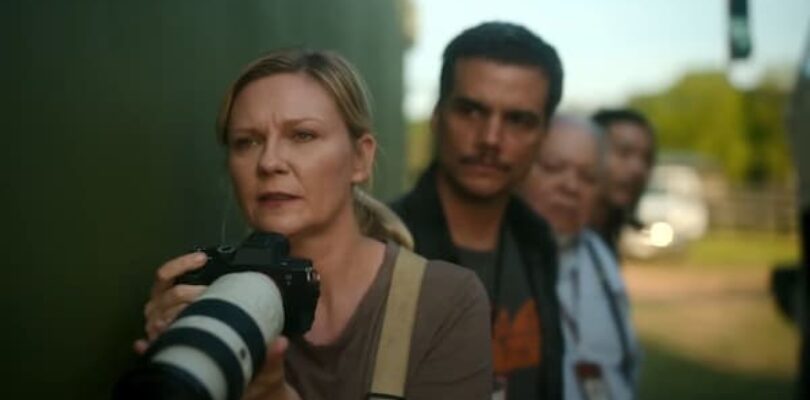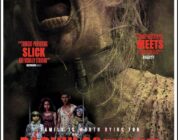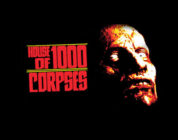This column was originally published as part of our newsletter The Daily Show on April 17, 2024. Subscribe here. (We’re awesome about not spamming your inbox!)
Alex Garland’s Civil War is essentially a dystopian zombie movie stripped of its metaphors. What’s left are the physical building blocks of this genre: human conflict. The supernaturalism is distilled into gun-toting naturalism. The visual spectacle is distilled into a sociopolitical lens. The flesh-eating zombies are restored to their original form: factions of armed rebels — some of them preying on each other — in war-torn America. The future can’t be scary because the present already is. A fascist government and their loyalist soldiers are crumbling in the face of nation-wide secessionist violence, and the Western Forces (militia movements from Texas and California) are closing in on the White House. The band of desperate survivors on the run are actually victims running towards the fire. The film revolves around a group of journalists driving towards Washington to ‘interview’ the president before he is captured. In other words, they hope to shoot the president before he is shot (dead).
Civil War. A24
The core of Garland’s science fiction (Ex Machina, Annihilation) is that his concepts are rarely distant. Civil War scales up and down at once. The protagonists with their cameras are battling the zombification — that is, the desensitisation — of their own species. They’ve spent so long chronicling the bloody descent of America that they don’t see red anymore. They feast on death and destruction. The irony is that the more they succeed at their job, the more infected they get.
They are designed like a family, too. There’s the “mother”: Famous war photographer Lee Smith (Kirsten Dunst) with the moral range of a wildlife photographer. She is haunted by what she sees, but she’s more haunted by the ghosts of her own dispassion; she’s the subject of her own undeveloped film negatives. There’s the “father”: Her colleague, Joel (Wagner Maura), with the adrenaline rush of an adventure junkie. There’s the “grandfather”: Their mentor, Sammy (Stephen McKinley Henderson), wants a lift but dislikes their idea of entering the eye of the storm. And there’s the “daughter”: Aspiring photographer Jessie (Cailee Spaeny) tags along under Lee’s unofficial mentorhood. Jessie looks up to a jaded Lee, but Lee envies Jessie, a young woman who’s still green enough to get affected by the sight of gore and gunfire. Lee resents her own sense of invincibility — or immortality — and her growing equation with Jessie repairs this.
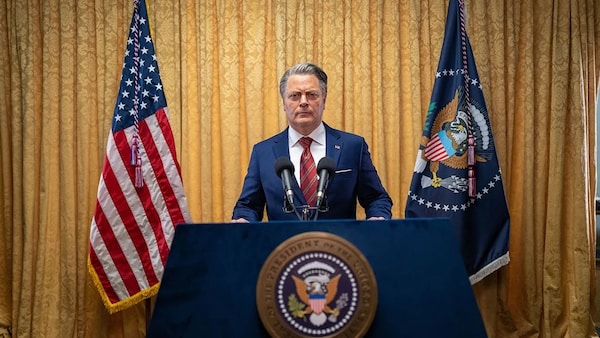
Civil War. A24
Jessie’s arc is that of a person mutating into an opportunistic freelancer. Lee notices that she’s getting better and more fearless at invading stillness, which also means that she’s getting worse at being human. In genre terms, the increasingly protective Lee realises that her own undead reputation — that of being sharp and ruthless enough to tango with history without taking sides — inspired Jessie to be bitten. She has, at least figuratively, created a baby-faced monster. Jessie almost dies a couple of times, but she admits that the addiction is real; “I felt so alive,” she confesses, with her shame dissipating into cold professional ambition. The film continuously chips away at the role of journalists and documentarians in this post-truth world. The needle drops and stylised imagery hint at the sort of fetishisation that reporters like them do to rationalise their work. They imagine their settings differently — dramatically — so that they can make art out of it.
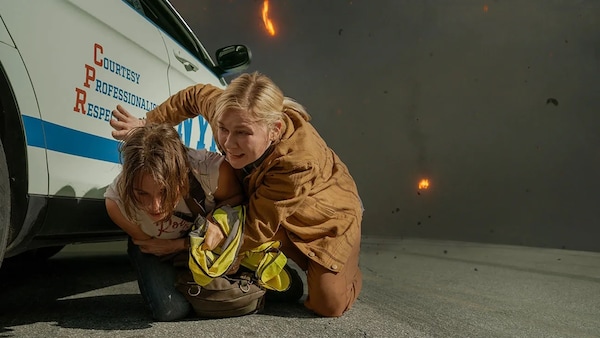
Civil War. A24
At times, they’re so consumed that they look like they’re directing a film in which the universe is performing for them. The illusion is inescapable. When the group follows a couple of militiamen attacking a building held by loyalist soldiers, they’re like cinematographers shadowing the perfect choreography of their characters. It’s almost like the attackers pose during executions for a great shot, an unsaid agreement with journalists who adapt their reality into the language of fiction. Once they brutally finish off the soldiers, Joel is seen joking around with them and sharing a cigarette, as if they’re all on a break while the next scene is being set up. Jessie observes this eerie relationship between history and the hungry recorders of it; Lee appears to ensure that she doesn’t socialise with the ‘actors’ who’re still high after pulling off a tough action sequence.
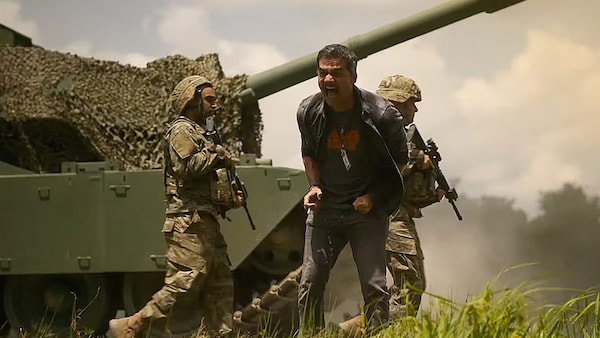
Civil War. A24
Later on, when the group tries to capture two silent snipers aiming into a house — they don’t even know who’s shooting at them — Lee finds herself taking refuge in the soft grass, with pretty dandelions surrounding her. It’s a disarmingly tranquil shot, and if seen without context, Lee could well be someone who’s enjoying a nice summer day while napping in the countryside. Her camera could be a half-read book. The film refuses to break her reverie, even as her colleagues continue to snap the snipers. Jessie convinces her to try on a dress in another scene, at a store in a town that’s blissfully oblivious of the war around them. She blushes, as the camera is turned on her for a change. You can sense Lee flirting with retirement from the life of getting shot (at). You can also sense Jessie flirting with the numbness of committing to that same trauma.
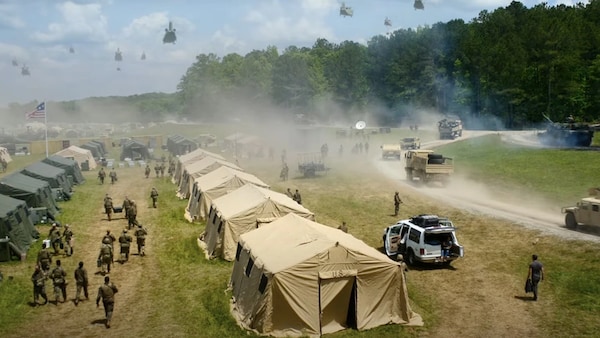
Civil War. A24
The performances do justice to these deceptively complex themes. A special mention to Jesse Plemons, who makes a cameo as an ultranationalist and racist rebel soldier; he gives the film its most relatable scene, holding the reporters at gunpoint while asking them where they’re from. The parallels one can draw with him in 2024 — in most minority-hating authoritarian regimes parading as dysfunctional democracies — is frightening. Kirsten Dunst lends Lee that veteran-transformation voice; there’s a lot of meta-channelling, especially with Lee’s weary gaze after having been there and done it all. It’s nearly like Dunst, the actress who’s been around for three decades, is genuinely guiding and looking out for the talented Cailee Spainey (as Jessie), who’s only just broken onto the scene with Priscilla. They share an uncanny mentor-protege chemistry, but one that’s also customised to fit the cannibalistic parameters of modern journalism. It’s both hopeful and tragic, like seeing rare plants bloom in the middle of a parched desert only to realise that the mirages are strong.
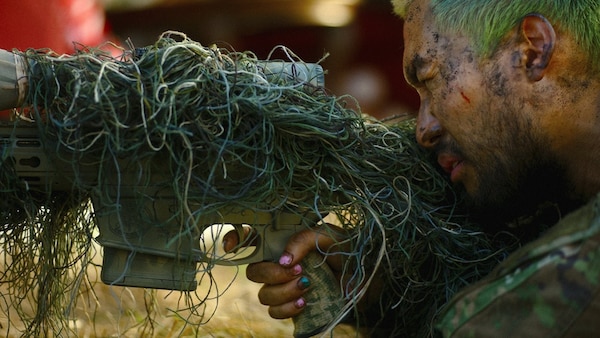
Civil War. A24
The chaotic climax unfolds in Washington. A lot of it brings to mind Dan Gilroy’s Nightcrawler, a moody thriller about a stringer who symbolises the thin line between voyeuristic demand and unethical supply. Civil War is more mainstream — a term I never thought I’d use for an A24 production — but in a way that evokes the spirit of a Gerard Butler B-movie strolling through an art exhibition. The tropes are unyielding in their submission to higher meaning. Garland’s deft film-making leaves no stone unturned to suggest that, in the current climate, the one who pulls the trigger is often indistinguishable from the one who shoots. Humans who go to any lengths to break a story are often people who’ve conditioned themselves to the act of breaking. After all, there’s nothing civil about the war within.

